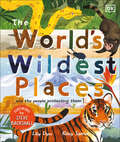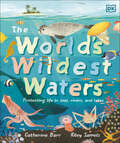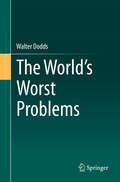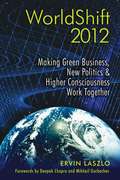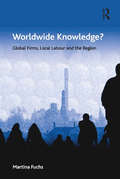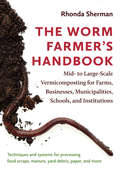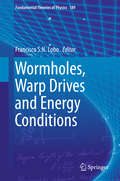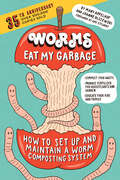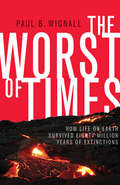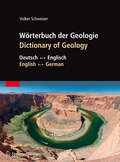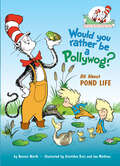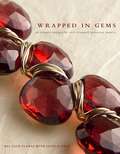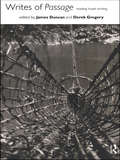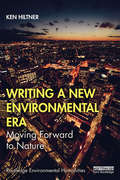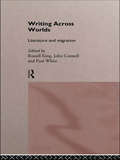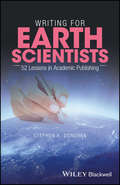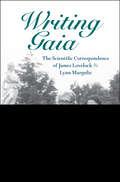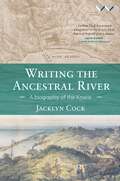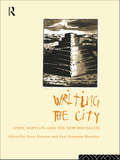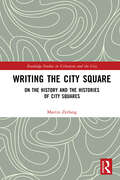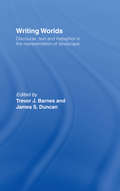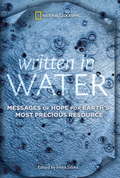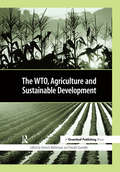- Table View
- List View
The World's Wildest Places: And the People Protecting Them
by Lily DyuDiscover the wildest places on earth, and meet the amazing people dedicating their lives to conserving them.The World&’s Wildest Places engages adventurous and curious children with the action being taken to combat the human impact on Planet Earth. Young readers can embark on the journey of a lifetime to 20 of the world's wildest places! Explore each environment, and learn about the keepers who are working to preserve them for future generations. Meet the animals and plants who call the wilderness home, and discover how you can take active steps to make a difference. Featuring colorful original illustrations and stunning photography, The World's Wildest Places brings the excitement of the jungle and the adventure of the rainforest to your lap.This striking conversation book for kids features: - 20 incredible locations across six continents, from tropical rainforests to deserts.- Combines stunning illustrations and photography to bring the places, people and animals to life.- Accessible text providing young readers with an easy introduction to conservation and the environment.- Hide and Seek / Search and Find activities for every location make reading fun.- Highlights the conservation work that is underway across the globe.This awe-inspiring environment book is the perfect addition to the library of curious 6+ year olds with an interest in animals, adventure and exploration, alongside caregivers seeking to empower children to bring about positive change to the planet. Celebrate your child&’s curiosity as they dive into the wild and wonderful scenes of the world&’s most stunning habitats, with clear and accessible text that offers young readers an entry-point to conservation and the environment. Featuring a foreword by WLT patron and well-known naturalist Steve Backshall, this amazing animal book was developed in collaboration with World Land Trust, a conservation charity protecting the world&’s most threatened habitats.
The World's Wildest Waters: Protecting Life in Seas, Rivers, and Lakes
by Catherine BarrA beautifully presented entry point text about our oceans and other watery worlds for 6 years and upDive into the world&’s wildest oceans, lakes, and rivers, and get ready for an underwater adventure!Embark on the journey of a lifetime to 20 of the world&’s wildest waters! Explore each environment and learn about the people who are working to preserve them for future generations. Meet the creatures who call these watery worlds home and discover how you can take active steps to make a difference. Featuring colorful original illustrations and stunning photography, The World&’s Wildest Waters brings the excitement of the high seas and the mystery of the ocean&’s dark, hidden depths to your lap.
The World's Worst Problems
by Walter DoddsThis book addresses the worst problems currently facing humanity and those that may pose future threats. The problems are explained and approached through a scientific lens, and categorized based on data involving global mortality, vulnerability, and threat level. The book presents indices of problem severity to compare relative intensity of current and potential crises. The approach avoids emotional argument using mainly empirical evidence to support the classification of relative problem severity. The author discusses multiple global problems and ranks them. He also explores specific solutions to each problem, links problems to human behavior from a social science perspective, considers international cooperation, and finally pathways to solutions.The book discusses confirmation bias and why this necessitates a scientific approach to tackle problems. The moral assumption that each person has the same rights to life and minimal suffering, and that the natural world has a right to exist, forms the basis of ranking problems based on death, suffering, and harm to the natural world. A focus is given to potential disasters such as asteroid collisions and super-volcanic eruptions, which are then presented in chapters that address specific contemporary global issues including disease, hunger, nuclear weapons and climate change. Furthermore the author then ranks the problems based on an index of problem severity, considering what other people think the worst problems are. The relative economic costs to solve each of these problems, individual behavior in the face of these problems, how people could work together internationally to combat them, and a general pathway toward solutions form the basis of the final chapters. This work will appeal to a wide range of readers, students considering how they can help the world, and scientists and policy makers interested in global problem solving.
WorldShift 2012: Making Green Business, New Politics, and Higher Consciousness Work Together
by Deepak Chopra Ervin Laszlo Mikhail GorbachevA handbook for conscious change that could transform the current world crisis into planetary renewal • Outlines the problems that make today’s world prone to breakdown and suggests actions we must adopt in politics, business, and everyday life • Replaces the limited consciousness of our failing society with the holistic consciousness that is rooted in the Akashic field The deepening economic crisis and the threat posed by climate change and other social and ecological trends has caused many to despair. But with great danger comes great opportunity--the opportunity for fundamental change that will transform our societies from top to bottom. In WorldShift 2012, Ervin Laszlo brings together insights for creating sustainable positive change from spiritual leaders, scientists, and visionary businesspeople--people such as Albert Einstein, Mohammad Yunus, Václav Havel, Eckhart Tolle, Ken Wilber, David Korten, Paul Hawken, and Tomoyo Nonaka, former CEO of Sanyo Electronics. He shows how we can replace the limited consciousness of our failing society with the holistic consciousness that is reflected in the unified field of quantum physics: the Akashic field. We have an opportunity to move from the current political and business model of grow or die to a sustainable world respectful of human beings, nature, and the planet. Change on this level calls for a profound shift in consciousness and a clear understanding that--as cutting-edge physics shows--we are truly connected with each other and with the cosmos. This book presents clear evidence of this connectedness and describes the tools we need to make our world greener and our planet safer as we strive to realize the holistic consciousness of connection through the Akashic field.
Worldwide Knowledge?: Global Firms, Local Labour and the Region (Economic Geography Series)
by Martina FuchsPutting forward a comprehensive view of knowledge with a specific perspective on place and space, this book provides a new perspective on the globalisation of knowledge. Crossing disciplinary boundaries, the principal agenda of this volume is to open up a perspective ’beyond knowledge’ - i.e. beyond the interpretation of knowledge as scientific-technical knowledge. Author Martina Fuchs introduces further kinds of knowledge and interpretation which influence managements’ perception of globalisation and therefore the knowledge which is going global. She refers to knowledge in the sense of experiences, competencies in the production and labour process, as well as mutually shared mental constructs which are embedded in a context of understanding and interpretation. Exploring beyond the meaning of worldwide knowledge as general open access knowledge, this book also discusses barriers to knowledge, problems of transfer, and the influence of governance and control.
The Worm Farmer’s Handbook: Mid- to Large-Scale Vermicomposting for Farms, Businesses, Municipalities, Schools, and Institutions
by Rhonda ShermanTechniques and systems for processing food scraps, manure, yard debris, paper, and more Turning waste into wealth sounds too good to be true, but many worm farmers are finding that vermicomposting is a reliable way to do just that. Vermicast—a biologically active, nutrient-rich mix of earthworm castings and decomposed organic matter—sells for $400 or more per cubic yard. Compare that to regular compost, sold at about $30 a cubic yard, and you’ll see why vermicomposting has taken root in most countries and on every continent but Antarctica. Vermicomposting is also one of the best sustainable solutions for organic waste management. Vermicomposting manure and crop wastes on farms improves crop yields while reducing demand for off-farm inputs. Vermicast has higher nutrient levels and lower soluble salt content than regular compost, and it improves soil aeration, porosity, and water retention. Plus, vermicast suppresses plant diseases and insect attacks. Municipalities, businesses, community gardens, schools, and universities can set up vermicomposting operations to process food residuals and other waste materials. The Worm Farmer’s Handbook details the ins and outs of vermicomposting for mid- to large-scale operations, including how to recycle organic materials ranging from food wastes and yard trimmings to manure and shredded office paper. Vermicomposting expert Rhonda Sherman shares what she has learned over twenty-five years working with commercial worm growers and researchers around the world. Her profiles of successful worm growers across the United States and from New Zealand to the Middle East and Europe describe their proven methods and systems. This book digs into all the details, including: Choosing the right production system Regulatory issues and developing a business and marketing plan Finding and managing feedstocks Pre-composting: why and how to do it Monitoring an active worm bed Harvesting, screening, testing, packaging, and storing vermicast Markets for earthworms and vermicast Food security: how vermicast benefits soils and plants Keys to success: avoiding common pitfalls From livestock farms and restaurants to colleges, military bases, and prisons, Sherman details why and how commercial-scale vermicomposting is a fast-growing, sustainable solution for organic waste management. The Worm Farmer’s Handbook is the first and only authoritative how-to guide that goes beyond small-scale operations and demystifies the science and logistics of the fascinating process that is vermicomposting.
Wormholes, Warp Drives and Energy Conditions
by Francisco S. LoboTop researchers in the field of gravitation present the state-of-the-art topics outlined in this book, ranging from the stability of rotating wormholes solutions supported by ghost scalar fields, modified gravity applied to wormholes, the study of novel semi-classical and nonlinear energy conditions, to the applications of quantum effects and the superluminal version of the warp drive in modified spacetime. Based on Einstein's field equations, this cutting-edge research area explores the more far-fetched theoretical outcomes of General Relativity and relates them to quantum field theory. This includes quantum energy inequalities, flux energy conditions, and wormhole curvature, and sheds light on not just the theoretical physics but also on the possible applications to warp drives and time travel.This book extensively explores the physical properties and characteristics of these 'exotic spacetimes,' describing in detail the general relativistic geometries that generate closed timelike curves.
Worms Eat My Garbage, 35th Anniversary Edition: How to Set Up and Maintain a Worm Composting System: Compost Food Waste, Produce Fertilizer for Houseplants and Garden, and Educate Your Kids and Family
by Mary Appelhof Joanne OlszewskiFor more than three decades, this best-selling guide to the practice of vermicomposting has taught people how to use worms to recycle food waste into nutrient-rich fertilizer for houseplants or gardens. Small-scale, self-contained worm bins can be kept indoors, in a basement, or even under the kitchen sink in an apartment — making vermicomposting a great option for city dwellers and anyone who doesn&’t want or can&’t have an outdoor compost pile. The fully revised 35th anniversary edition features the original&’s same friendly tone, with up-to-date information on the entire process, from building or purchasing a bin (readily available at garden supply stores) to maintaining the worms and harvesting the finished compost.
The Worst of Times
by Paul B. WignallTwo hundred and sixty million years ago, life on Earth suffered wave after wave of cataclysmic extinctions, with the worst--the end-Permian extinction--wiping out nearly every species on the planet. The Worst of Times delves into the mystery behind these extinctions and sheds light on the fateful role the primeval supercontinent, known as Pangea, may have played in causing these global catastrophes.Drawing on the latest discoveries as well as his own firsthand experiences conducting field expeditions to remote corners of the world, Paul Wignall reveals what scientists are only now beginning to understand about the most prolonged and calamitous period of environmental crisis in Earth's history. He describes how a series of unprecedented extinction events swept across the planet in a span of eighty million years, rapidly killing marine and terrestrial life on a scale more devastating than the dinosaur extinctions that would come later. Wignall shows how these extinctions--some of which have only recently been discovered--all coincided with gigantic volcanic eruptions of basalt lavas that occurred when the world's landmasses were united into a single vast expanse.Unraveling one of the great enigmas of ancient Earth, The Worst of Times also explains how the splitting apart of Pangea into the continents we know today ushered in a new age of vibrant and more resilient life on our planet.
Wörterbuch der Geologie / Dictionary of Geology
by Volker SchweizerWissenschaftliche Publikationen werden heute fast nur noch in Englisch verfasst. Sowohl für das Verständnis englischsprachiger Fachliteratur als auch für das Verfassen eigener Publikationen braucht man dringend ein verlässliches Fachwörterbuch. Auch Wissenschaftlern, deren Muttersprache nicht Deutsch ist, wird es für das Verständnis deutschsprachiger Literatur eine große Hilfe sein. Volker Schweizer hat sich als erfahrener Übersetzer großer geologischer Lehrbücher eine hohe Kompetenz erworben und dieses Wörtebuch zusammengestellt.
The Worth of Water: Designing Climate Resilient Rainwater Harvesting Systems
by Liam McCarton Sean O'Hogain Anna ReidThere is no more fundamental substance to life on earth than water. Three quarter of the Earth’s surface is covered by either saltwater or freshwater, yet millions face a daily struggle to access enough water for survival. The effects of ongoing climate change have expanded the water crisis to areas previously considered water secure. This book addresses the role rainwater harvesting (rwh) can play in developing a resilient water infrastructure that will prove adaptive to climate change. The book features three sections. The first section presents the concepts underpinning a new approach to water infrastructure. The term “the worth of water” was developed to reflect the importance of the social life of water. This encompasses all human relationships with water including the social, cultural, hydrological, political, economic, technical and spiritual. A technology portfolio showcasing the worth of water from the Qanats of the ancient world to the modern Rain Cities is presented. Other concepts discussed include the circular economy of water and the concept of multiple waters for multiple users of multiple qualities. Water and its properties are a function of its peculiar molecular structure and this is illustrated in the book. Rainwater harvesting is considered by the authors as containing an inherent treatment train which functions as a complex water treatment system providing physical, chemical and biological removal mechanisms. Part two presents a new design methodology together with design templates and worked examples for the hydraulic and economic analysis of rwh systems. A state-of-the-art literature review of the potential health implications of utilizing rwh is also presented. The final section of the book discusses how rwh can play a vital role in contributing to achieving the Sustainable Development Goals and to living within the Planetary Boundaries.
Would You Rather Be a Pollywog: All About Pond Life (Cat in the Hat's Learning Library)
by Bonnie WorthCats normally don't like water, but the Cat in the Hat is no normal puss! He’s fond of ponds, and in this latest Cat in the Hat’s Learning Library book, he takes Sally and Dick on a trip to show them how ponds are fascinating places teeming with life.From algae to snails, leeches, insects, fish, frogs, newts, turtles, ducks, swans, and more, the Cat explains how all different kinds of plants and animals make their home in and around ponds, as well as examining the difference between complete and incomplete metamorphosis and the various stages of frog development. Ideal for spring and summer reading, this is a beginning reader that will inspire kids to get outside and explore!
Wrapped in Gems: 40 Elegant Designs for Wire-wrapped Gemstone Jewelry
by Mai Sato-Flores Jesse FloresFew people would argue against the beauty and appeal of gemstone jewelry, but some jewelry makers find themselves intimidated by the thought of working with these precious stones. With Wrapped in Gems, even inexperienced jewelry makers can learn to fashion their own beautiful gemstone creations using Mai Sato-Flores's preferred techniques of wire wrapping and working with chain. This method allows gems to hang so that light can shine through and show off their natural beauty. For the jewelry maker, inspiration can be found anywhere, but the exquisite beauty of nature is a favorite source. Take a moment to study the leaves of a tree or plant-the contours of a leaf suggest a shape for a pendant, the perfect combination of colors in the leaves and flowers hint at a color palette of precious gemstones to mimic it. The branches and twigs, the patterns of leaf growth, even the shape of the tree or plant itself can inspire ideas for earrings, bracelets, necklaces, and rings. Wrapped in Gems shows you how to interpret all that you see in nature to create jewelry with wire, chains, and beautiful gemstones. New York City-based jewelry designer Mai Sato-Flores is inspired by nature wherever she goes-be it the supermarket, Central Park, or right outside her door. In Wrapped in Gems, she shares the secrets of her work and the natural elements that inspire it. After demonstrating how gemstones and wire can be used to recreate the patterns and designs of nature, Mai provides instructions for 40 elegant pieces of gemstone jewelry from her own collections.
Writes of Passage: Reading Travel Writing
by James Duncan Derek GregoryWrites of Passage explores the interplay between a system of "othering" which travelers bring to a place, and the "real" geographical difference they discover upon arrival. Exposing the tensions between the imaginary and real, Duncan and Gregory and a team of leading internationa contributors focus primarily upon travelers from the 18th and 19th Centuries to pin down the imaginary within the context of imperial power. The contributors focus on travel to three main regions: Africa, South Asia, and Europe - wit the European examples being drawn from Britain, France and Greece.
Writing a New Environmental Era: Moving forward to nature (Routledge Environmental Humanities)
by Ken HiltnerWriting a New Environmental Era first considers and then rejects back-to-nature thinking and its proponents like Henry David Thoreau, arguing that human beings have never lived at peace with nature. Consequently, we need to stop thinking about going back to what never was and instead work at moving forward to forge a more harmonious relationship with nature in the future. Using the rise of the automobile and climate change denial literature to explore how our current environmental era was written into existence, Ken Hiltner argues that the humanities—and not, as might be expected, the sciences—need to lead us there. In one sense, climate change is caused by a rise in atmospheric CO2 and other so-called greenhouse gases. Science can address this cause. However, approached in another way altogether, climate change is caused by a range of troubling human activities that require the release of these gases, such as our obsessions with cars, lavish houses, air travel and endless consumer goods. The natural sciences may be able to tell us how these activities are changing our climate, but not why we are engaging in them. That’s a job for the humanities and social sciences. As this book argues, we need to see anthropogenic (i.e. human-caused) climate change for what it is and address it as such: a human problem brought about by human actions. A passionate and personal exploration of why the Environmental Humanities matter and why we should be looking forward, not back to nature, this book will be essential reading for all those interested in the future and sustainability of our planet.
Writing Across Worlds: Literature and Migration
by Russell King John Connell Paul WhiteInternational migration has long been a dominant feature of world literature from both post-industrial and developing countries. The increasing demands of the global economic system and continued political instability in many of the world's region have highlighted this shifting map of the world's peoples.Yet, political concern for the larger scale economic and social impact of migration has effectively obscured the nature of the migratory nature of the migratory experience itself, the emotions and practicalities of departure, travel, arrival and the attempt to rebuild a home.Writing Across Worlds explores an extraordinary range of migration literaturesm from letters and diaries to journalistic articles, autobiographies and fiction, in order to analyse the reality of the migrant's experience. The sheer range of writings - Irish, Friulian, Italian, Jewish and South Asian British, Gastarbeiter literature from Germany, Pied noir, French-Algerian and French West Indian writing, Carribbean novels, Slovene emigrant texts, Japanese-Canadian writing, migration in American novels, narratives from Australia, South Africa, Samoa and others - illustrate the diversity of global migratory experience and emphasise the social context of literature.The geographic and literary range of Writing Across Worlds makes this collection an invaluable analysis of migration, giving voice to the hope, pain, nostalgia and triumph of lives lived in other places.
Writing for Earth Scientists: 52 Lessons in Academic Publishing
by DonovanThe time has come. You are an Earth scientist. You’ve spent weeks, months, years working on this project – now is the time to pull it together for publication. You might be writing an undergraduate or graduate thesis, a research paper for a leading journal, a note for the newsletter of the local amateur scientific society, a book review or an abstract for a specialist geological conference. How do you make the transition from promising unpublished researcher to established academic author? Of course, the phrase ‘academic publishing’ covers a multitude of sins; monographs, research papers, book reviews, conference abstracts or whatever each requires a different approach. You have to decide what it is you are going to write and where to publish it. There are co-authors, supervisors of your degree, peer reviewers and editors to deal with on the way. But the only way to write like an academic is to write like an academic. . . where do you start? You could do much worse than start here. There are many books on how to write and be published aimed at research students and other aspiring academics. Many of these are readable, comprehensive and provide good advice. This book is composed of numerous short chapters on this subject, all directly relevant to one or more aspects of academic publishing and aimed particularly at the Earth scientists in the broadest sense. Geologists will be encouraged to use the book as much as a reference as a reader, ‘dipping in’ to the chapters that contain relevant tips, hints and comments to enable them to improve the paper that they are currently writing. The book is intended to be informative, readable and, above all, of practical application for all readers. In summary, the volume will be a readable compilation investigating many facets of academic publishing relevant to the Earth sciences. It will be of particular interest to postgraduate students, postdocs and new academics
Writing Gaia: The Scientific Correspondence of James Lovelock and Lynn Margulis
by Bruce Clarke Sébastien DutreuilIn 1972, James Lovelock and Lynn Margulis began collaborating on the Gaia hypothesis. They suggested that over geological time, life on Earth has had a major role in both producing and regulating its own environment. Gaia is now an ecological and environmental worldview underpinning vital scientific and cultural debates over environmental issues. Their ideas have transformed the Earth and life sciences, as well as contemporary conceptions of nature. Their correspondence describes these crucial developments from the inside, showing how their partnership proved decisive for the development of the Gaia hypothesis. Clarke and Dutreuil provide historical background and explain the concepts and references introduced throughout the Lovelock-Margulis correspondence, while highlighting the major landmarks of their collaboration within the sequence of almost 300 letters written between 1970 and 2007. This book will be of interest to researchers in ecology, history of science, environmental history and climate change, and cultural science studies.
Writing the Ancestral River: A Biography of the Kowie
by Jacklyn CockWriting the Ancestral River is an illuminating and unusual biography of the Kowie River in the Eastern Cape. This tidal river runs through the centre of what used to be called the Zuurveld, a formative meeting ground of different peoples who have shaped our history: Khoikhoi herders, Xhosa pastoralists, Dutch trekboers and British settlers. Their direct descendants continue to live in the area and interact in ways that have been decisively shaped by their shared history. Besides being a social history, this is also a natural history of the river and its catchment area, where dinosaurs once roamed and cycads still grow. As the book shows, the natural world of the Kowie has felt the effects of human settlement, most strikingly through the establishment of a harbour at the mouth of the river in the 19th century and the development of a marina in the late 20th century. Both projects have had a decisive and deleterious impact on the Kowie. People are increasingly reconnecting with nature and justice through rivers. Acknowledging the past, and the inter-generational, racialised privileges, damages and denials it established and perpetuates, is necessary for any shared future. By focusing on this `little' river, the book raises larger questions about colonialism, capitalism, `development' and ecology, and asks us to consider the connections between social and environmental injustice.
Writing the City: Eden, Babylon and the New Jerusalem
by Peter Preston Paul Simpson-Housley`The expression of human experience it embodies ... includes all personal history'. Saul Bellow's view of the city is far from that of classic geographical descriptions which look at growth or decline, demographic patterns, traffic flows and economic potential: these empirically conceived models of urban geography fail to accommodate the crucial human aspect of city life. Located at the interface of geography and literature, Writing the City visualizes the city through the hopes, aspirations, disappointments and pains of international novelists and creative writers. From Manchester, Montreal and Sydney to Osaka, Varanasi amd Odessa, cities become more than their built environment, more than a set of class or economic relationships: they are also an experience to be lived, suffered and undergone. Thus cities are seen in terms of the innocence of an Eden now lost, a threat of sinful Babylon and the promise of a New Jerusalem.
Writing the City Square: On the History and the Histories of City Squares (Routledge Studies in Urbanism and the City)
by Martin ZerlangThe history of cities is also the history of city squares. The agora, the forum, the piazza, the plaza: All presuppose the idea of a center. It’s a material and mental phenomenon. Literature is an important part of this history, and the interplay between the square as physical space and the square as literature is the topic of this book. This is an encyclopedic book combining an overview of the history of city squares with a plethora of analytical examples of its reflection in literature: Literature uses the city square as a frame; city squares serve as frames for drama; novels and other kinds of literature comment on city squares; city squares are sources of inspiration for all sorts of literary activities. Socrates in the agora, Cicero in the Forum, Calderón in the Plaza Mayor, Corneille in the Place Royale, Richardson in Grosvenor Square, James in Washington Square, Woolf in Bloomsbury Square, Döblin and Gröschner in Alexanderplatz, Rodoreda in Diamond Square in Barcelona, DeLillo in Times Square, Al Aswany in Tahrir Square, the Maidanistas in the Maidan of Kyiv: These are just some of the examples presented and analyzed in this book. The book is of direct interest for researchers, students, and professionals such as architects and urban planners, but it is written in a way that makes it accessible for all readers with an interest in urban culture, architecture, history, literature, and cultural studies.
Writing Worlds: Discourse, Text and Metaphor in the Representation of Landscape
by Trevor J. Barnes James S. DuncanWriting Worlds represents the first systematic attempt to apply poststructuralist ideas to landscape representation. Landscape - city, countryside and wilderness - is explored through the discourse of economics, geopolitics and urban planning, travellers descriptions, propaganda maps, cartography and geometry, poetry and painting. The book aims to deconstruct geographical representation in order to explore the dynamics of power in the way we see the world.
Written in Water
by Irena SalinaWritten in Water: Messages of Hope for Earth's Most Precious Resource comprises a collection of essays authored by heroes and leaders in the field of water solutions and innovations--a broad range of people from varied disciplines who have contributed their hearts and minds to bringing awareness to and conserving Earth's freshwater supply. In their own words, authors tell of such tragedies as water slavery, drought, or contamination, as well as their own professional struggles and successes in pursuit of freshwater solutions. Contributors include: Alexandra Cousteau, social environmental advocate and granddaughter of legendary marine scientist Jacques Cousteau; Peter Gleick, environmental visionary and winner of a 2003 MacArthur "genius grant"; Bill McKibben, bestselling author and winner of a Guggenheim fellowship; Sylvia Earle, oceanographer and Time magazine's first "hero for the planet"; and Christine Todd Whitman, former head of the Environmental Protection Agency, along with more than a dozen other notable people.These visionaries' stories touch, surprise, and amaze as they help us see the essential role played by water in our world, our lives, and our future. These are all people who are thinking far beyond the realm of self; they are devoted to creating a better world for all of us.
Written in Water
by Irena SalinaWritten in Water is an unforgettable collection of the true stories of people-men and women, politicians and scientists, laymen and experts-sharing in their own words what they have seen and what they have learned in their efforts to bring clean water to all.
The WTO, Agriculture and Sustainable Development
by Heinrich Wohlmeyer Theodor QuendlerDespite the Doha declaration of November 2001, the failure to start a new round of global trade negotiations at Seattle in December 1999 and the hostility of protesters to the trade liberalization process and growing global economic and social disparities was a wake-up call for the World Trade Organisation (WTO). The ambitious goal of this ground-breaking book is to identify the strengths and weaknesses of liberalized world trade, in particular in the agricultural sector, and to investigate to what extent the current WTO agreements provide the necessary fail-safe devices to react to trade-related negative impacts on sustainability, environmental protection and food security. The background and interrelationship between the WTO, the tenets of sustainable development and the unique features of the agriculture and forestry sectors are explored, and conclusions regarding the deficits of the world trade system and its conflicts with basic societal goals – such as sustainability – are drawn. Agriculture and forestry have a particular affinity with what the authors call "strong sustainability" and are to be among the major agenda items in forthcoming WTO negotiations. The book proposes that sustainable agricultural production techniques such as integrated and organic farming provide a series of related services to community and environment which could be severely prejudiced by wholesale trade liberalization and the imposition of the large-scale production methods of the mega-trade giants of the USA and Europe. And yet the concept of sustainability is referred to only tangentially in the existing WTO agenda. The WTO, Agriculture and Sustainable Development argues that, without a formal recognition of this failing, the premise that free trade is inherently advantageous for all countries is a falsehood. Further, unfettered liberalization is unsustainable and a social and environmental multilateral framework must be agreed to reinterpret or adapt a host of WTO regulations that are at odds with sustainable development. The core problem is that, under the current system, import duties can only be differentiated by direct goods and services and not by their means of production – sustainable or otherwise. Therefore, a range of environmental policy measures in the agricultural sector, such as the consideration of product life-cycles, the internalization of external costs and a coupling of trade liberalization with ecological obligations are proposed by the authors. In addition, they argue that unsustainable economic short-termism must be curbed and the use of the stick of trade sanctions and the carrot of financial benefits for good environmental performance be permitted to promote sustainable agricultural practices. This book will contribute greatly in addressing the lack of basic theoretical arguments at the intersection between trade and sustainable development – a failing that has already been bemoaned by trade policy-makers. It is highly recommended reading for all those involved or interested in the WTO negotiations, whether from multilateral organizations, governments, industry or civil society.
